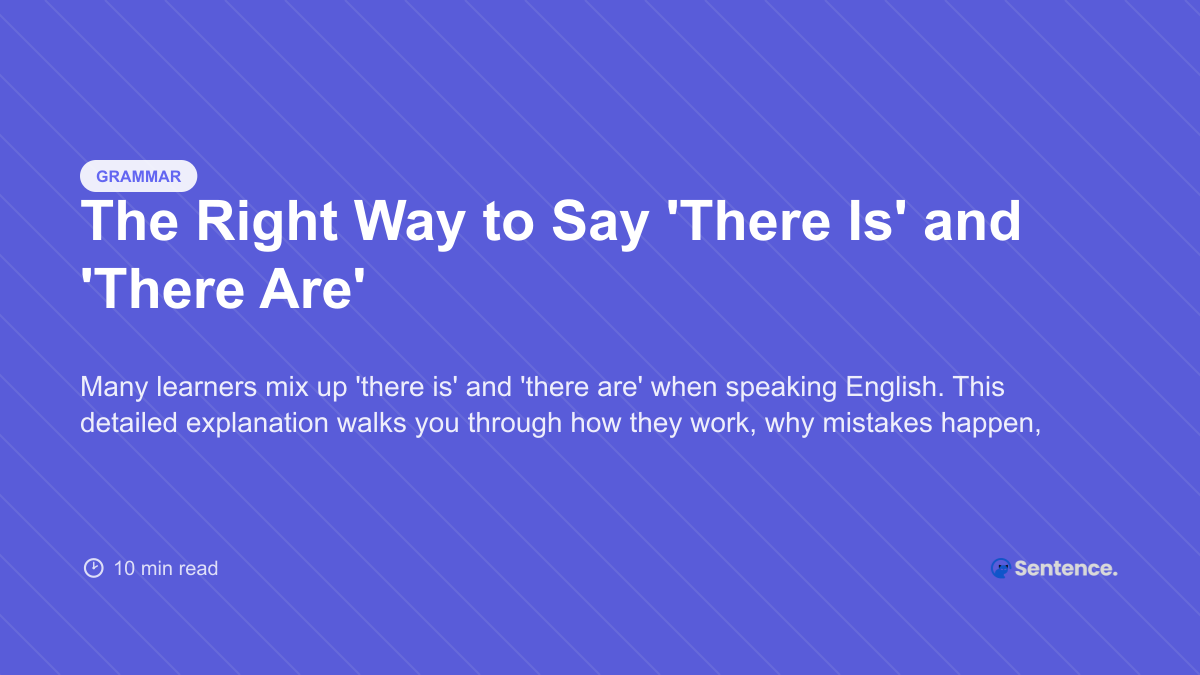
The Right Way to Say 'There Is' and 'There Are'
Many learners mix up 'there is' and 'there are' when speaking English. This detailed explanation walks you through how they work, why mistakes happen, and how to use them naturally in real situations.

Many learners mix up 'there is' and 'there are' when speaking English. This detailed explanation walks you through how they work, why mistakes happen, and how to use them naturally in real situations.
If you’ve ever said a sentence like “There is many people in the park” or “There are a cat on the sofa,” you already know how confusing these two small phrases can be. The difference between there is and there are may look small, but it affects how natural your English sounds. Once you understand how they really work, you’ll start using them correctly without even thinking about it.
Let’s walk through what they mean, when to use each one, and some simple tricks to help you remember. You’ll also find a few short tables and examples to make it easier to visualize everything.
We use these expressions to talk about the existence or presence of something — basically, to say that something “is there.”
Here’s the basic idea:
| Form | Used With | Examples |
|---|---|---|
| There is | Singular nouns or uncountable nouns |
There is a book on the table. There is some milk in the fridge. |
| There are | Plural nouns |
There are three chairs in the room. There are many students outside. |
Think of it this way: if you can count it (one, two, three…), use there are. If not, or if there’s just one thing, use there is.
Which one is correct?
Answers: There is a pen / There are two pens
Even when learners know the rule, they still make small mistakes — often because they speak too quickly or forget about uncountable nouns. Let’s look at the most frequent problems.
| Mistake | Why It’s Wrong | Correct Form |
|---|---|---|
| There is many people here. | “People” is plural. | There are many people here. |
| There’s two apples on the table. | “There’s” = “There is” (singular only). | There are two apples on the table. |
| There are some furniture in the room. | “Furniture” is uncountable. | There is some furniture in the room. |
Notice how most mistakes happen when learners confuse plural and uncountable nouns. Once you get used to identifying those, you’ll rarely make these errors again.
These structures follow a simple pattern when we make questions or negative sentences. You can remember them like this:
| Type | Structure | Example |
|---|---|---|
| Question | Is/Are + there + noun | Is there a supermarket near here? Are there any eggs left? |
| Negative | There isn’t / There aren’t + noun | There isn’t any water left. There aren’t enough chairs. |
Now it’s your turn to practice. Look around your room, your desk, or even outside your window, and describe what you see. Make one sentence with “there is,” one with “there are,” and one negative sentence. For example, you could say: “There is a clock on the wall,” “There are two books on the bed,” and “There isn’t any noise outside.” Doing this a few times a day will help you remember the difference naturally without having to think about the rule every time.
Once you understand the pattern, you can use it in any tense. The forms change depending on time, but the logic stays the same:
| Tense | Singular / Uncountable | Plural | Example |
|---|---|---|---|
| Past | There was | There were | There were many guests yesterday. |
| Present | There is | There are | There are books on the table. |
| Future | There will be | There will be a meeting tomorrow. | |
As you can see, it’s always about matching the verb to the number of things you’re talking about — one vs. more than one.
The best way to remember these structures is by actually using them in real life. Try these simple daily habits:
Try this mini quiz:
Answers: There is / There are / There is / There are
Once you start practicing regularly, you’ll notice that you stop translating and start speaking naturally. “There is” and “there are” will become instinctive — just like native speakers use them every day without thinking about the rules.
Getting comfortable with “there is” and “there are” is more than just a grammar rule — it’s about learning how English describes what exists in the world around you. These phrases appear in almost every kind of sentence, from everyday small talk to professional writing. The real key is noticing the noun that follows. If it’s one thing or something you can’t count, use “there is.” If it’s more than one, use “there are.”
Keep describing what you see, read, and hear every day using both forms. The more you use them, the more natural they’ll feel. Eventually, you won’t pause to think about which one is correct — it will just sound right. That’s the moment when grammar turns into fluency.
If you’d like to practice more, check out our interactive exercises to test your understanding and track your progress. Remember, small improvements made consistently lead to confident English communication.